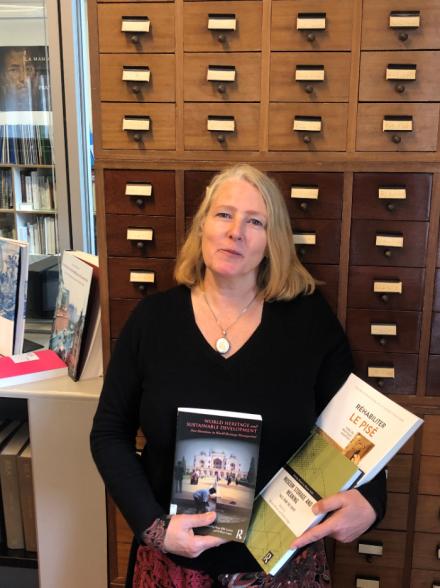Book Review: Selected Acquisitions: ICCROM Library
Submitted by sharragrow on

Reviews by Daniela Sauer
For the June 2019 issue of News in Conservation, the ICCROM Library is contributing a list of new acquisitions and summaries of a selected group of top titles hand-picked by the librarian. We look forward to this being a regular quarterly inclusion in News in Conservation going forward.
The list of acquisitions includes all new acquisitions of recently published titles (2018-2019, with very few exceptions) that became part of The ICCROM Library collection in the second half of 2018 and 2019 (download the full PDF here). In this way, we hope to give you a panoramic view of newly published titles in the field. For this list, we decided to omit all titles published before 2018 (both purchases and donations) as including them all would have produced too looooong of a list. But don’t let that stop you from exploring our entire catalogue here: (https://www.iccrom.org/resources/library-services). For any further information please contact: Daniela Sauer ds@iccrom.org; library@iccrom.org
To give you a taste of our newest holdings, I present a few of my favourites below:
. . .
Réhabiliter le pisé : Vers des pratiques adaptées
By Sébastien Moriset
Arles: Actes Sud, 2018
ISBN: 9782330092580; Page count: 262 p.; ICCROM: XIX G 303
Link to catalogue: http://biblio.iccrom.org/cgi-bin/koha/opac-detail.pl?biblionumber=122981
The International Centre for Constructions in Earth Construction (CRAterre) just published a key resource for the conservation of adobe constructions. It addresses matters related to diagnosis, maintenance and project planning and dedicates the main part of the book to step-by-step instructions for the rehabilitation of earthen buildings.
. . .
World Heritage and Sustainable Development: New Directions in World Heritage Management
By Peter Bille Larsen and William Logan
Abingdon: Routledge (Key Issues in Cultural Heritage), 2018
ISBN: 9781138091405; Page count: xvi, 293 p.; ICCROM: XXXIV 61; ICCROM: XXXIV electronic resource 2
Link to catalogue: http://biblio.iccrom.org/cgi-bin/koha/opac-detail.pl?biblionumber=122825
Link to catalogue: http://biblio.iccrom.org/cgi-bin/koha/opac-detail.pl?biblionumber=123234
In a world where severe challenges such as climate change, armed conflicts, poverty and other negative factors impact the wellbeing of our societies, the adoption of the Sustainable Development Policy in 2015 by the World Heritage Convention represented a milestone in the contribution of cultural heritage to the achievement of the Sustainable Development Goals. What constitutes the historical background, and what are the main aspects of the policy? Who are the main actors? How is the policy implemented in the field? These and many other questions are answered in this publication.
In 2015 the General Assembly of State Parties to the World Heritage Convention passed a ground-breaking Sustainable Development policy that seeks to bring the World Heritage system into line with the UN’s sustainable development agenda (UNESCO 2015). World Heritage and Sustainable Development provides a broad overview of the process that brought about the new policy and the implications of its enactment. The book is divided into four parts. Part I puts the policy in its historical and theoretical context, and Part II offers an analysis of the four policy dimensions on which the policy is based—environmental sustainability, inclusive social development, inclusive economic development and the fostering of peace and security. Part III presents perspectives from IUCN, ICOMOS and ICCROM—the three advisory bodies to the World Heritage Committee, and Part IV offers case study perspectives on the practical implications of the policy. Contributions come from a wide range of experienced heritage professionals and practitioners who offer both inside perspectives on the evolution of the policy and outside perspectives on its implications. Combined, they present and analyse the main ideas, debates and implications of the policy change. This book is key reading for all heritage professionals interested in developing a better understanding of the new Sustainable Development policy. It is also essential reading for scholars and students working in the area. (Summary from back cover)
. . .
Museum Storage and Meaning: Tales from the Crypt
By Mirjam Brusius and Kavita Singh
Abingdon, Oxon, New York, NY: Routledge, an imprint of the Taylor & Francis Group (Routledge research in museum studies, 14), 2018
ISBN: 9781138065978; Page count: xv, 290 p.; ICCROM: III G 50
Link to ICCROM Library catalogue: http://biblio.iccrom.org/cgi-bin/koha/opac-detail.pl?biblionumber=122064
Last but not least… Have you ever dreamed about someone taking you by the hand, whispering “close your eyes” and guiding you into hidden, unknown museum spaces? Then open the magic doors of this book!
Beyond their often beautiful exhibition halls, many museums contain vast, hidden spaces in which objects may be stored, conserved or processed. Museums can also include unseen archives, study rooms and libraries which are inaccessible to the public. This collection of essays focuses on this domain, an area that has hitherto received little attention. Divided into four sections, the book critically examines the physical space of museum storage areas, the fluctuating historical fortunes of exhibits, the growing phenomenon of publicly visible storage and the politics of objects deemed worthy of collection but unsuitable for display. In doing so, it explores issues including the relationship between storage and canonization, the politics of collecting, the use of museum storage as a form of censorship, the architectural character of storage space and the economic and epistemic value of museum objects. Essay contributions come from a broad combination of museum directors, curators, archaeologists, historians and other academics. (Summary from back cover)
Daniela Sauer
Librarian, Conservation Specialist
ICCROM Library
ds@iccrom.org
library@iccrom.org